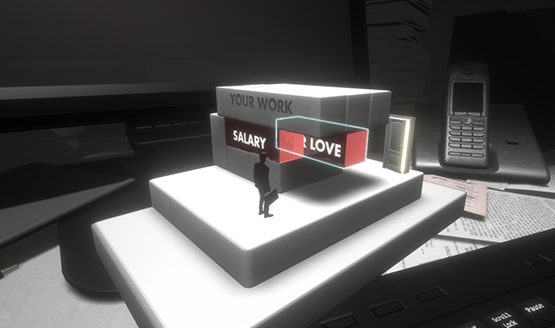Everybody likes Jenga right? The tower-building game where you pull pieces out of an ever growing and ever more unstable tower is addicting and unpredictable. And everyone can relate to working for the man, the dull drudgery of the daily work grind. Dilbert is only one of the most popular comics because of its instant relatability. Salary Man Escape seeks to combine Jenga-like puzzles with a parody of that stereotypical business grind, to mixed results.
Initially, Salary Man Escape revels in a kind of simplicity. You move red blocks around to get Salary Man to the exit door, apparently some kind of metaphor for the escape from that daily grind, hence the name. The puzzles start out with simply moving blocks out of the way and get progressively more complex. Just when one mechanic begins to become tired, the game introduces a new one, including conveyor belts, weighted scales, and glass pieces that can shatter. The evolution of the puzzle mechanics always kept me engaged just at the moment when I thought the game would become as dull as office work.
At times, the later puzzles in each of the mechanic’s sections grew to be quite frustrating. This stemmed from confusing design, poor controls, and janky physics, which in a physics-based puzzler, is a huge breaking point. Confusing design is acceptable. In fact, it’s a primary component in puzzle design. Levels are supposed to be confusing. When that confusion is a question of whether or not I’m doing the puzzle correctly or just getting hung up on bad object physics, that’s a recipe for frustration. Most of my “ah ha!” moments in Salary Man Escape weren’t revelations of how the puzzle was supposed to be solved, but a realization that the block wasn’t actually supposed to get hung up on that other object.
Workday Collisions
One of the fundamental parts of Jenga is finding those loose pieces, and understanding how moving a single piece might impact the balance of the entire structure. While the idea of a (vastly more complex) digital Jenga is something that sounds enticing, in practice you lose some of that physical understanding of the structure being manipulated. I often didn’t realize the puzzle was on the precarious edge of tumbling until it was too late. There needs to be a better balance between physics realism that causes weird hangups on objects and player-friendly mechanics that allow the game to actually be playable.
Salary Man Escape does support two control methods. You can either use a DualShock 4 or a single Move. While the Move feels a lot more like the “definitive” control scheme, it suffers from intermittent tracking issues. Not being able to use a second Move to manipulate each puzzle feels limiting in a lot of ways, but I can see that creating even more issues with tracking and object collision physics. It’s possible that the very limiting nature of a single Move controller actually mitigates even more serious issues.
The aesthetic is a noir-like black and white, with interactive objects cast in red. Though the colors stay the same throughout, the visuals of the game evolve through changing design of levels. Size and shape of the various objects change, and the different puzzle mechanics have distinctly different looks. While the black and white look is designed specifically to make the game evoke that monotonous nine to five drudge, it somehow manages to remain at least remotely interesting from puzzle to puzzle, area to area.
Hidden levels can be unlocked by collecting various optional coins in the main levels. These hidden levels present even more of a crazy challenge by doing things like turning out the lights and making your controller a flashlight. As some of the most difficult puzzles in the game, however, these puzzles are the ones that can suffer from the physics issues the most. Instead of getting easier, the game gets more complex, thus creating more opportunities for collision issues throughout the experience.
Mimicking the Grind
To really parody the workday grind, each level features a letter from management when selecting it. These mimic the kind of humor that you might find in something like Dilbert, making obvious and heavy-handed statements about corporate culture. Unfortunately these moments of brevity feel disconnected from the puzzles themselves and pretty soon I didn’t want to spend time reading through each one before playing the next level. had this parody of the culture been better tied into the actual levels themselves, it may have been a more interesting commentary.
One major redeeming feature is the persistent and driving ’80s Japanese pop soundtrack that weaves its way between English and Japanese lyrics, once again evoking that grind and making light of it. It’s a dichotomy that made me grin in even the most frustrating of moments and helped keep me playing for longer than I otherwise would have, though there was a point after retrying levels over and over again where even the soundtrack found a level of monotony. I guess that’s playing into exactly what the game is parodying, though I doubt that was the intention.
Salary Man Escape is an interesting idea for a puzzle game, but its execution ends up being more along the lines of the very drudgery that it tries to parody, rather than the escape that video games promise. It relies a little bit too heavily in its physics, which creates object collision issues in the more complex later levels. Fortunately, the driving ’80s Japanese pop soundtrack helped to drive away the feelings of frustration and boredom that threatened to overwhelm the Salary Man. When object collision isn’t getting in the way, Salary Man Escape is an interesting VR puzzler, but like finding moments of respite in the nine to five, those moments are all too rare.
Conan Exiles review code provided by publisher. Version 1.00 reviewed on a standard PS4. For more information on scoring, please read our Review Policy.
-
A Jenga-styled puzzler
-
Parody of the 9 to 5 grind
-
Driving '80's J-pop soundtrack
-
Disconnect between puzzles and parody
-
Major collision and physics issues
-
Gets as monotonous as the very thing it parodies
Salary Man Escape Review July 2018
-
Salary Man Escape

-
Salary Man Escape

-
Salary Man Escape

-
Salary Man Escape

-
Salary Man Escape










